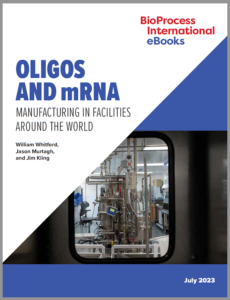eBook: Oligos and mRNA — Manufacturing in Facilities Around the World
Sponsored by Polyplus
 Three years ago, mRNA biotechnology was poised to provide just what the world needed to fight SARS-CoV-2. Researchers already had been working to develop nucleotide therapies for cancers and infectious disease, and the pandemic gave companies an immediate proving ground for speeding up development and demonstrating what such technology could accomplish. Capitalizing on the resulting success, developers of mRNA and related oligonucleotides now are looking to the future and addressing a number of manufacturing challenges to ensure widespread access to such therapeutics around the world.
Three years ago, mRNA biotechnology was poised to provide just what the world needed to fight SARS-CoV-2. Researchers already had been working to develop nucleotide therapies for cancers and infectious disease, and the pandemic gave companies an immediate proving ground for speeding up development and demonstrating what such technology could accomplish. Capitalizing on the resulting success, developers of mRNA and related oligonucleotides now are looking to the future and addressing a number of manufacturing challenges to ensure widespread access to such therapeutics around the world.
In this eBook, science writer Jim Kling provides an update on the state of the science and business of mRNA development. He highlights key manufacturing challenges, particularly those related to product stability, and talks to experts in industry and academia who are finding ways to address the problem of access for far-flung countries without the necessary infrastructure to protect finicky formulations. In South Africa, Afrigen has worked with the World Health Organization to form an mRNA technology hub that will provide regional access to vaccines and other mRNA products. Meanwhile, companies in Europe and the United States are refining manufacturing technologies and lyophilization approaches to improve the stability of lipid-nanoparticle–based formulations.
Next, BPI editorial advisor William Whitford and his colleague Jason Murtagh detail the path that developers in the wider oligonucleotide therapeutic world are taking their manufacturing processes into a future. Sustainability and flexibility are increasingly important goals across the pharmaceutical industry, and the authors show how the two can go hand in hand. Aqueous processes are replacing those based on hazardous organic solvents, for example, bringing aseptic environments and closed systems to prominence. But companies will need to consider water conservation, especially in downstream processing. Suppliers of equipment, materials, and services can help.
Fill out the form below to read the full eBook now.
You May Also Like





